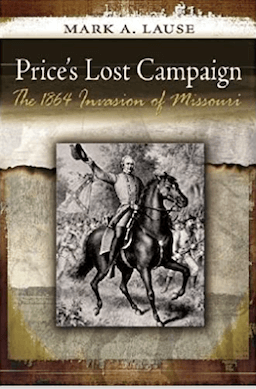Price's Lost Campaign: The 1864 Invasion of Missouri facts for kids

Front cover
|
|
| Author | Mark A. Lause |
|---|---|
| Country | United States |
| Language | English |
| Subject | Price's Raid |
| Genre | Non-fiction |
| Publisher | University of Missouri Press |
|
Publication date
|
2011 |
| Pages | 280 |
| ISBN | 978-0-8262-1949-7 |
Price's Lost Campaign: The 1864 Invasion of Missouri is a book from 2011 by Mark A. Lause. It was published by the University of Missouri Press. This book tells the story of the early parts of Price's Raid. This was a big military movement during the American Civil War in 1864.
The book explores how this event, which started as a full-scale invasion, later became known as a smaller "raid." It also looks at the actions of Confederate leader Sterling Price and Union leader William S. Rosecrans. Lause challenges old stories that said Confederate soldiers always acted honorably during the war. The book stops its story when Price decided not to attack Jefferson City, Missouri. The author believes this is when the invasion changed into a raid.
Reviewers have praised the book for being fair and well-researched. They liked how Lause looked at the campaign without taking sides. A second book, The Collapse of Price's Raid, came out in 2016. It finishes the story of the campaign.
Contents
About the Book's Story
Price's Lost Campaign was written by Mark A. Lause. He is a history professor at the University of Cincinnati. He has written many books about the 1800s, especially about the American Civil War. He also writes about the history of working people in the United States.
The Start of Price's Raid
Lause's book focuses on the first parts of Price's Raid. This was a military campaign that happened in late 1864. It was a key event during the American Civil War. The book covers everything from the very beginning of the campaign. It ends when Sterling Price, the Confederate commander, decided not to try and capture Jefferson City, Missouri.
Invasion or Raid?
The book explains that Price's campaign was first planned as a big Confederate invasion. The goal was to take Missouri away from Union control. Lause argues that it only later became a smaller "raid." The author believes that when Price chose not to attack Jefferson City, the campaign changed. It stopped being a full invasion and became more of a raid.
Challenging Old Stories
A main idea in the book is to challenge common myths about the Civil War. For example, some old stories suggest that Confederate soldiers avoided "total war." Total war means fighting that includes damaging property and harming civilians. Lause's book shows that this was not always true. He mentions that during the campaign, there was some looting and even harm to civilians. Some of these civilians were even Confederate supporters.
Leaders and Their Choices
The book also looks at the choices made by the leaders on both sides. It examines why Union Major General William S. Rosecrans reacted to the raid the way he did. Lause suggests that Rosecrans was more worried about protecting Missouri's economy than its people. Sterling Price is also criticized in the book. Lause suggests Price cared more about his own good name than winning the campaign.
What Else is in the Book?
At the end of the book, there are helpful appendixes. These include a timeline of the events and an order of battle. An order of battle lists the military units and their commanders. Lause believes that both sides later changed the story of the campaign. They made it sound like a less important raid for their own reasons. In 2016, Mark Lause published a follow-up book. It is called The Collapse of Price's Raid. This second book tells the rest of the story of the campaign.

